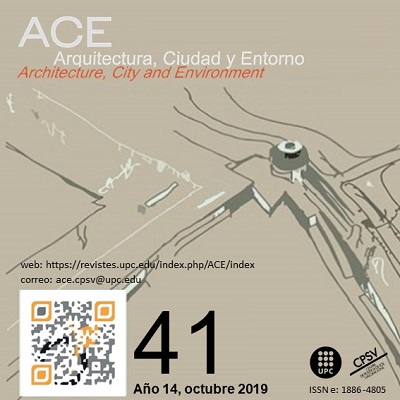Hygrothermal conditioning in an urban module through human propulsion electric cycle power for warm climates
DOI:
https://doi.org/10.5821/ace.14.41.7035Keywords:
Bio-healthy architecture, Energy saving, Sustainable architecture, Sustainable construction, SustainabilityAbstract
Objective
Utilization of the energy obtained through the recreational use of the leisure zones by means of human-powered traction using mini-bike pedals as a renewable source intended to produce accumulative energy. Energy is generated through the physical and sporty activity of pedalling. Such energy is subsequently accumulated in batteries using two alternators for its later use transforming it into environmental conditioning and lighting.
Methodology
A system capable of transforming physical exercise into power generation intended for lighting, artificial shade, and coolness is proposed. This system provides a solution to obtain artificial shade and coolness by means of the nebulization of water vapour in environments of hard urbanism, which allows humanizing the city through a participative citizen action. Such nebulization is obtained through the process of transforming the human renewable source of pedaling into energy for environmental conditioning and hygrothermal comfort through a bioclimatic strategy.
Conclusions
A study is carried out in order to analyse the bioclimatic conditions of the environment in order to create urban facilities, which guarantee optimal habitability conditions by taking advantage of those factors, which provide quality of life and social development, such as environmental aesthetics, level of environmental stress, pedestrian areas, and leisure zones, among others.
Originality
In the recent past years, the design of urban facilities, which encourage social relations and a healthy life, is in increasing evolution referring to the first designs installed in the parks and gardens of the cities. However, nowadays there is not system capable of integrating more significantly physical exercise and power generation intended for lighting, artificial shade, and coolness.
Downloads
Published
Issue
Section
License
| INTELECTUAL PROTECTION CRITERIA |
At this moment, it is count with the "Oficina Española de Patentes y Marcas", while global protection it is being processed by the World Intelectual Property Organization (OMPI/WIPO). Nevertheless the International Standard Serial Number Office (ISSN) has given the following numbers ISSN: 1886-4805 (electronic version) and 1887-7052 (paper version). All articles will be peer reviewed, using double blind reviewing. |
| COPYRIGHT |
The article contents and their comments are authors exclusive liability, and do not reflect necessarily the journal editor commitee's opinion. All ACE published works are subject to the following licence CC BY-NC-ND 3.0 ES http://creativecommons.org/licenses/by-nc-nd/3.0/es/ It implies that authors do not hold nor retain the copyright without restrictions but only those included in the licence. |





































